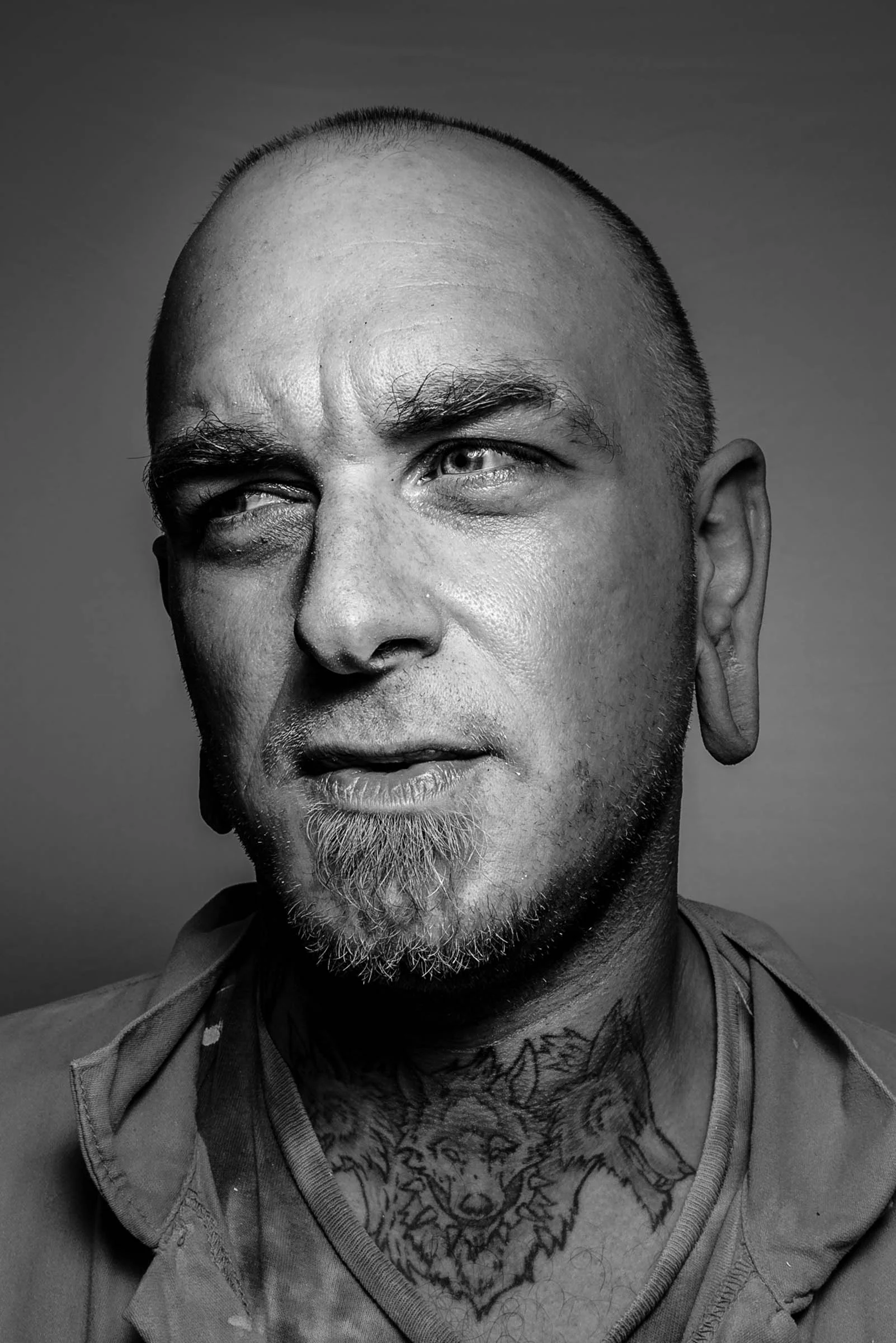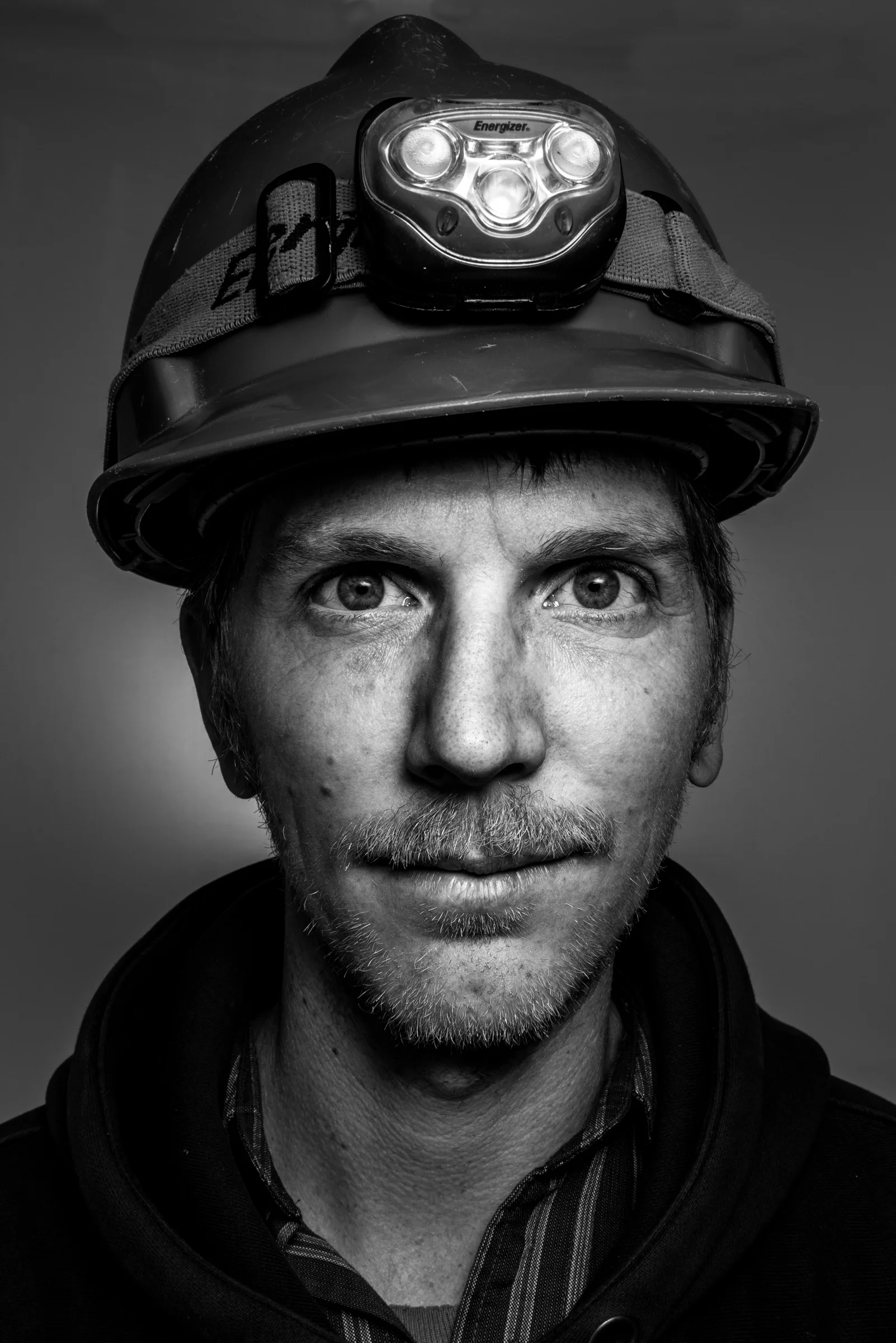






Backstory
Backstory
Genesis
Curious about the gritty, hardhat-wearing workers at a shipyard in their own backyard, two people from Bath, Maine set out to document the faces and voices of a blue-collar culture existing in their blind spot.
"Driving back from the beach in a minivan filled with kids, I’m stuck in traffic in the big crosswalk in front of the shipyard. The shipbuilders are out on their lunch break, loitering around the gate, smoking, texting, walking past and around my van, which is now in their way. They’re dressed in green coveralls, paint splattered Patriots sweatshirts, beat up hardhats covered in union stickers. Their hands and faces are dirty. I’m both interested and curious and also uncomfortable in their presence. We lead such different lives, but we live together in this small city. In this awkward moment, and many others like it, I want to know who these shipbuilders are, and what they do". - Hopper McDonough
"We bought an old shipbuilder’s house in 1999, just two blocks up the road from Bath Iron Works. I fell in love with this house because it’s built like a ship - tall but narrow, filled with hatches and births for efficient storage. When I look out of my windows, I see the profile of the Yard - tall cranes reaching into the sky. For nearly two decades what I’ve known is this: I don’t prefer to run past The Yard at 11:30 a.m., amid a dense crowd of workers on their break who I don't know anything about, Once in a while, I see a very large warship float down the river. That has been the extent of my knowledge about the Yard. How can I have lived here for so long, in a small city so rich with a shipbuilding legacy, in proximity to such a huge group of people, building something so significant, and know nearly nothing about any of them?" - Heather Perry
The City
Bath, Maine, The City of Ships. Population: 8,500. North of Portland, about an hour drive. A mix of white and blue collar, rich and poor, Maine natives and those "from away". Historic homes ramble up from the banks of the Kennebec River, and an old-fashioned Main Street fills with tourists during the short summer. The dominant feature of the skyline here is a massive red and white crane at Bath Iron Works, one of the last major American shipyards.
The Yard
Shift whistle, break whistle, lunch whistle, shift whistle. Massive buildings on a mile of waterfront. Towering cranes. Three gates, through which 6,000 workers pass each day to assemble highly advanced destroyers for the US Navy. The southgate, as it is known, is where many of the welders, pipe fitters, painters, marine electricians, ship fitters, and insulators congregate between shifts and during breaks. It's a place where these union workers refer to themselves as brothers and sisters, and the southgate is their turf.

Shipbuilders
Shipbuilders
Tight, dark, dirty spaces. Smoke. Grit. Ladders ladders ladders, most with a crew going the opposite way. Every kind of noise: grinding metal, alarms, clanging steel plates, grunts, laughter. The Yard and the ships under construction are so big that many shipbuilders don't have time to walk out of the gates on their 30-minute lunch break. Of those who do, some have taken some of this precious time to step into our booth and tell us how they feel about being a shipbuilder. These are some of the questions we ask them:
- Describe the space you are working in today.
- How important is it to work with a good crew?
- What's a good day at work? What's a bad day?
- What do you do when you're not building ships?
- What did the launch of the Zumwalt mean to you? What about the loss of the Coast Guard bid?
- How do you think the results of the recent presidential election will impact the future of the Yard?
Mike. Welder.
Michael. Painter.
Jenna. Ship Fitter.
Caleb. Ship Fitter.
Matt. Welder.
Frank. Painter.
Paul. Tin Shop.
Josh. Electrician.
Nick. Electrician.
Matt. Painter.
Chris. Painter.
Eli. Ship Fitter.
Connie. Deck Planner.
Travis. Electrician.
Ramsey. Pipe Tester.
Kaleb. Ship Fitter.
Dan. Pipe Fitter.
Roger. Rigger.
Mike. Shop Steward.
Devin. Pipe Fitter.

Audio Themes
Audio Themes
One question, many voices.
Pride
How does it feel when one of these ships is completed and heads down the Kennebec River?
Environment
Describe the spaces and conditions you work in.
Good Things
What do you like about building ships at Bath Iron Works?
Hard Things
What is hard about building ships at Bath Iron Works?
Fears
Can this job ever be scary or intimidating?
Legacy
Do you feel a connection to the shipbuilding history of Bath?
The Election
How do you think the 2016 Presidential Election will impact the future of Bath Iron Works?

Contributors
Contributors
Heather Perry • Photography
Heather is an editorial and commercial photographer living and working just two blocks from the Yard.
Hopper McDonough • Sound
Hopper is an entrepreneur and audiographer living and working just a mile from the Yard.
Evolution
We've documented 62 shipbuilders so far, collecting audio and images and sharing them via Facebook and Instagram.
About halfway through the first 50, in the heat of the presidential election, it became evident to us that this project was timely, weighty. Since the election, it's become even more evident that what we're doing has importance. Beyond being the voices of the working middle class, these are the neighbors we didn't know.
When we started, we couldn't have predicted that this work would accompany us through a chaotic political storm, but now it seems like there's never been a better time to listen to differing perspectives.
We’ve completed our work at BIW with a total of 65 sound portraits. Beyond the skilled workers at the Yard, we know there are men and women working in the trades throughout Maine. We'll keep looking and listening, and hope to illuminate their feelings about the fulfilling, stable, important jobs they do. - Heather & Hopper

Behind the Portraits
Behind the Portraits
PORTABLE STUDIO
Once we decided to make sound portraits with Bath's shipbuilders, our challenge was to bring a photo studio to them. We designed and built a framework from PVC pipe and wrapped it in shade fabric. We made arrangements to set it up in a parking spot next to a restaurant right across the street from Southgate.
SET UP AND WAIT
We can set up the booth in about 30 minutes. After that, we do a few test shots and eat a giant cookie we’ve bought from the local diner beside us. This cookie has gone from being hunger stopper, to nervous habit, to good luck charm, to safety vest. Every time, we remind ourselves that these guys are busy, tired, on a break and owe us nothing. There’s anxiety in asking for even a few minutes of their time. Another bite of cookie for courage.
When the 11:30 break whistle blows, the shipbuilders pour out of Southgate, a river of hard hats crossing Washington Street. We wait with our portable studio booth, an island in their path.
Most huddle in groups, eating their lunch, smoking cigarettes, just taking a break. Some of them break away from these groups and come check us out. Sometimes we ask if they've seen what we're doing on social media, ask if they would like to participate. Sometimes we just wait. Sometimes we interview 6 shipbuilders in that 30 minutes. Sometimes nobody is willing, and we have a 30-minute standoff with no photos. We know that these days are important, too.
Once someone steps into our photo booth with us, Hopper asks a series of questions, and Heather makes photographs while the shipbuilder answers. After we are done, we send them off with a gift card for free lunch at the diner. We email each shipbuilder their portrait within a day or two.
THANK YOU
We recognize the courage and trust it takes for a shipbuilder on a short break to give us even a few minutes of their time. We are strangers to them, on their time and turf, and we are so grateful for their generosity and sharing.
Thanks also to Fiona's Catering, the Bath Police Department, and Brackett's Market.

Contact
Heather Perry | Hopper McDonough
Bath, Maine.
Contact
Heather Perry | Hopper McDonough
Bath, Maine.
INQUIRIES
+1 207 720 0540
heatherperryphoto@mac.com




























